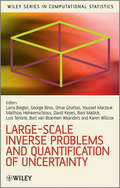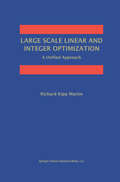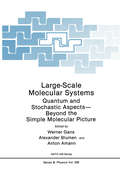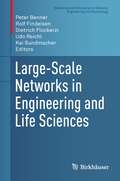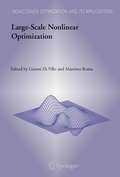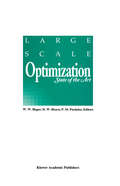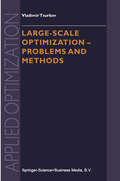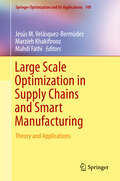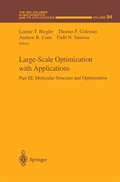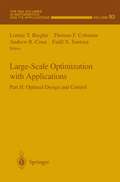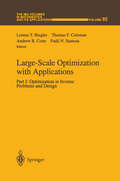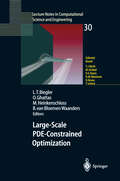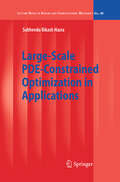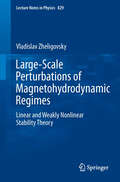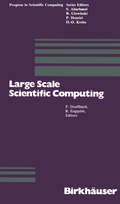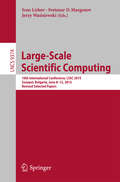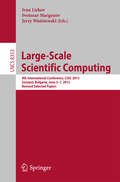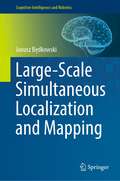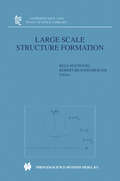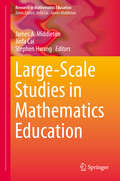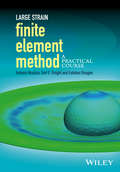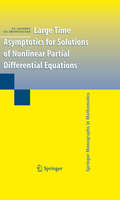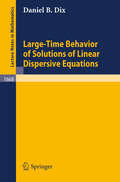- Table View
- List View
Large-Scale Inverse Problems and Quantification of Uncertainty (Wiley Series in Computational Statistics #712)
by Lorenz Biegler George Biros Omar Ghattas Matthias Heinkenschloss David Keyes Bani Mallick Youssef Marzouk Luis Tenorio Bart van Bloemen Waanders Karen WillcoxThis book focuses on computational methods for large-scale statistical inverse problems and provides an introduction to statistical Bayesian and frequentist methodologies. Recent research advances for approximation methods are discussed, along with Kalman filtering methods and optimization-based approaches to solving inverse problems. The aim is to cross-fertilize the perspectives of researchers in the areas of data assimilation, statistics, large-scale optimization, applied and computational mathematics, high performance computing, and cutting-edge applications. The solution to large-scale inverse problems critically depends on methods to reduce computational cost. Recent research approaches tackle this challenge in a variety of different ways. Many of the computational frameworks highlighted in this book build upon state-of-the-art methods for simulation of the forward problem, such as, fast Partial Differential Equation (PDE) solvers, reduced-order models and emulators of the forward problem, stochastic spectral approximations, and ensemble-based approximations, as well as exploiting the machinery for large-scale deterministic optimization through adjoint and other sensitivity analysis methods. Key Features: Brings together the perspectives of researchers in areas of inverse problems and data assimilation. Assesses the current state-of-the-art and identify needs and opportunities for future research. Focuses on the computational methods used to analyze and simulate inverse problems. Written by leading experts of inverse problems and uncertainty quantification. Graduate students and researchers working in statistics, mathematics and engineering will benefit from this book.
Large-Scale Inverse Problems and Quantification of Uncertainty (Wiley Series in Computational Statistics #708)
by Lorenz Biegler Youssef Marzouk David Keyes George Biros Omar Ghattas Matthias Heinkenschloss Bani Mallick Luis Tenorio Bart Van Bloemen Waanders Karen WillcoxThis book focuses on computational methods for large-scale statistical inverse problems and provides an introduction to statistical Bayesian and frequentist methodologies. Recent research advances for approximation methods are discussed, along with Kalman filtering methods and optimization-based approaches to solving inverse problems. The aim is to cross-fertilize the perspectives of researchers in the areas of data assimilation, statistics, large-scale optimization, applied and computational mathematics, high performance computing, and cutting-edge applications. The solution to large-scale inverse problems critically depends on methods to reduce computational cost. Recent research approaches tackle this challenge in a variety of different ways. Many of the computational frameworks highlighted in this book build upon state-of-the-art methods for simulation of the forward problem, such as, fast Partial Differential Equation (PDE) solvers, reduced-order models and emulators of the forward problem, stochastic spectral approximations, and ensemble-based approximations, as well as exploiting the machinery for large-scale deterministic optimization through adjoint and other sensitivity analysis methods. Key Features: Brings together the perspectives of researchers in areas of inverse problems and data assimilation. Assesses the current state-of-the-art and identify needs and opportunities for future research. Focuses on the computational methods used to analyze and simulate inverse problems. Written by leading experts of inverse problems and uncertainty quantification. Graduate students and researchers working in statistics, mathematics and engineering will benefit from this book.
Large Scale Linear and Integer Optimization: A Unified Approach
by Richard Kipp MartinThis is a textbook about linear and integer linear optimization. There is a growing need in industries such as airline, trucking, and financial engineering to solve very large linear and integer linear optimization problems. Building these models requires uniquely trained individuals. Not only must they have a thorough understanding of the theory behind mathematical programming, they must have substantial knowledge of how to solve very large models in today's computing environment. The major goal of the book is to develop the theory of linear and integer linear optimization in a unified manner and then demonstrate how to use this theory in a modern computing environment to solve very large real world problems. After presenting introductory material in Part I, Part II of this book is de voted to the theory of linear and integer linear optimization. This theory is developed using two simple, but unifying ideas: projection and inverse projec tion. Through projection we take a system of linear inequalities and replace some of the variables with additional linear inequalities. Inverse projection, the dual of this process, involves replacing linear inequalities with additional variables. Fundamental results such as weak and strong duality, theorems of the alternative, complementary slackness, sensitivity analysis, finite basis the orems, etc. are all explained using projection or inverse projection. Indeed, a unique feature of this book is that these fundamental results are developed and explained before the simplex and interior point algorithms are presented.
Large-Scale Molecular Systems: Quantum and Stochastic Aspects—Beyond the Simple Molecular Picture (Nato Science Series B: #258)
by Werner Gans Alexander Blumen Anton AmannThis NATO Advanced Study Institute centered on large-scale molecular systems: Quantum mechanics, although providing a general framework for the description of matter, is not easily applicable to many concrete systems of interest; classical statistical methods, on the other hand, allow only a partial picture of the behaviour of large systems. The aim of the ASI was to present both aspects of the subject matter and to foster interaction between the scientists working in these important areas of theoretical physics and theoretical chemistry. The quantum-mechanical part was mostly based on the operator-algebraic formulation of quantum mechanics and comprised quantum statistics of infinite systems with special em phasis on macroscopic observables, equilibrium conditions, irreversibility on the one hand, symmetry breaking for molecules in the radiation field and macroscopic quantum phenomena in the theory of superconductivity (BCS-theory) on the other hand. In addition, phase-space methods for many-body systems were also presented. Statistical physics was the main topic in the other lectures of the School; much emphasis was put on the statistical features of macros copic ("large") systems, the lectures dealt with mass and energy transport im polymers, in gels and in microemulsions, with aggregation and growth phenomena, with relaxation in complex, correlated systems, with conduction and optical properties of polymers, and with the means of describing disordered systems, above all fractals and related hierarchical models.
Large-Scale Networks in Engineering and Life Sciences (Modeling and Simulation in Science, Engineering and Technology)
by Peter Benner Rolf Findeisen Dietrich Flockerzi Udo Reichl Kai SundmacherThis edited volume provides insights into and tools for the modeling, analysis, optimization, and control of large-scale networks in the life sciences and in engineering. Large-scale systems are often the result of networked interactions between a large number of subsystems, and their analysis and control are becoming increasingly important. The chapters of this book present the basic concepts and theoretical foundations of network theory and discuss its applications in different scientific areas such as biochemical reactions, chemical production processes, systems biology, electrical circuits, and mobile agents. The aim is to identify common concepts, to understand the underlying mathematical ideas, and to inspire discussions across the borders of the various disciplines. The book originates from the interdisciplinary summer school “Large Scale Networks in Engineering and Life Sciences” hosted by the International Max Planck Research School Magdeburg, September 26-30, 2011, and will therefore be of interest to mathematicians, engineers, physicists, biologists, chemists, and anyone involved in the network sciences. In particular, due to their introductory nature the chapters can serve individually or as a whole as the basis of graduate courses and seminars, future summer schools, or as reference material for practitioners in the network sciences.
Large-Scale Nonlinear Optimization (Nonconvex Optimization and Its Applications #83)
by Gianni Pillo Massimo RomaThis book reviews and discusses recent advances in the development of methods and algorithms for nonlinear optimization and its applications, focusing on the large-dimensional case, the current forefront of much research. Individual chapters, contributed by eminent authorities, provide an up-to-date overview of the field from different and complementary standpoints, including theoretical analysis, algorithmic development, implementation issues and applications.
Large Scale Optimization: State of the Art
by William W. Hager D. W. Hearn Panos M. PardalosOn February 15-17, 1993, a conference on Large Scale Optimization, hosted by the Center for Applied Optimization, was held at the University of Florida. The con ference was supported by the National Science Foundation, the U. S. Army Research Office, and the University of Florida, with endorsements from SIAM, MPS, ORSA and IMACS. Forty one invited speakers presented papers on mathematical program ming and optimal control topics with an emphasis on algorithm development, real world applications and numerical results. Participants from Canada, Japan, Sweden, The Netherlands, Germany, Belgium, Greece, and Denmark gave the meeting an important international component. At tendees also included representatives from IBM, American Airlines, US Air, United Parcel Serice, AT & T Bell Labs, Thinking Machines, Army High Performance Com puting Research Center, and Argonne National Laboratory. In addition, the NSF sponsored attendance of thirteen graduate students from universities in the United States and abroad. Accurate modeling of scientific problems often leads to the formulation of large scale optimization problems involving thousands of continuous and/or discrete vari ables. Large scale optimization has seen a dramatic increase in activities in the past decade. This has been a natural consequence of new algorithmic developments and of the increased power of computers. For example, decomposition ideas proposed by G. Dantzig and P. Wolfe in the 1960's, are now implement able in distributed process ing systems, and today many optimization codes have been implemented on parallel machines.
Large-scale Optimization: Problems and Methods (Applied Optimization #51)
by Vladimir TsurkovDecomposition methods aim to reduce large-scale problems to simpler problems. This monograph presents selected aspects of the dimension-reduction problem. Exact and approximate aggregations of multidimensional systems are developed and from a known model of input-output balance, aggregation methods are categorized. The issues of loss of accuracy, recovery of original variables (disaggregation), and compatibility conditions are analyzed in detail. The method of iterative aggregation in large-scale problems is studied. For fixed weights, successively simpler aggregated problems are solved and the convergence of their solution to that of the original problem is analyzed. An introduction to block integer programming is considered. Duality theory, which is widely used in continuous block programming, does not work for the integer problem. A survey of alternative methods is presented and special attention is given to combined methods of decomposition. Block problems in which the coupling variables do not enter the binding constraints are studied. These models are worthwhile because they permit a decomposition with respect to primal and dual variables by two-level algorithms instead of three-level algorithms. Audience: This book is addressed to specialists in operations research, optimization, and optimal control.
Large Scale Optimization in Supply Chains and Smart Manufacturing: Theory and Applications (Springer Optimization and Its Applications #149)
by Jesús M. Velásquez-Bermúdez Marzieh Khakifirooz Mahdi FathiIn this book, theory of large scale optimization is introduced with case studies of real-world problems and applications of structured mathematical modeling. The large scale optimization methods are represented by various theories such as Benders’ decomposition, logic-based Benders’ decomposition, Lagrangian relaxation, Dantzig –Wolfe decomposition, multi-tree decomposition, Van Roy’ cross decomposition and parallel decomposition for mathematical programs such as mixed integer nonlinear programming and stochastic programming. Case studies of large scale optimization in supply chain management, smart manufacturing, and Industry 4.0 are investigated with efficient implementation for real-time solutions. The features of case studies cover a wide range of fields including the Internet of things, advanced transportation systems, energy management, supply chain networks, service systems, operations management, risk management, and financial and sales management. Instructors, graduate students, researchers, and practitioners, would benefit from this book finding the applicability of large scale optimization in asynchronous parallel optimization, real-time distributed network, and optimizing the knowledge-based expert system for convex and non-convex problems.
Large-Scale Optimization with Applications: Part III: Molecular Structure and Optimization (The IMA Volumes in Mathematics and its Applications #94)
by Lorenz T. Biegler Thomas Coleman Andrew R. Conn Fadil N. SantosaWith contributions by specialists in optimization and practitioners in the fields of aerospace engineering, chemical engineering, and fluid and solid mechanics, the major themes include an assessment of the state of the art in optimization algorithms as well as challenging applications in design and control, in the areas of process engineering and systems with partial differential equation models.
Large-Scale Optimization with Applications: Part II: Optimal Design and Control (The IMA Volumes in Mathematics and its Applications #93)
by Lorenz T. Biegler Thomas F. Coleman Andrew R. Conn Fadil N. SantosaWith contributions by specialists in optimization and practitioners in the fields of aerospace engineering, chemical engineering, and fluid and solid mechanics, the major themes include an assessment of the state of the art in optimization algorithms as well as challenging applications in design and control, in the areas of process engineering and systems with partial differential equation models.
Large-Scale Optimization with Applications: Part I: Optimization in Inverse Problems and Design (The IMA Volumes in Mathematics and its Applications #92)
by Lorenz T. Biegler Thomas F. Coleman Andrew Conn Fadil N. SantosaWith contributions by specialists in optimization and practitioners in the fields of aerospace engineering, chemical engineering, and fluid and solid mechanics, the major themes include an assessment of the state of the art in optimization algorithms as well as challenging applications in design and control, in the areas of process engineering and systems with partial differential equation models.
Large-Scale PDE-Constrained Optimization (Lecture Notes in Computational Science and Engineering #30)
by Lorenz T. Biegler Omar Ghattas Matthias Heinkenschloss Bart Van Bloemen WaandersOptimal design, optimal control, and parameter estimation of systems governed by partial differential equations (PDEs) give rise to a class of problems known as PDE-constrained optimization. The size and complexity of the discretized PDEs often pose significant challenges for contemporary optimization methods. With the maturing of technology for PDE simulation, interest has now increased in PDE-based optimization. The chapters in this volume collectively assess the state of the art in PDE-constrained optimization, identify challenges to optimization presented by modern highly parallel PDE simulation codes, and discuss promising algorithmic and software approaches for addressing them. These contributions represent current research of two strong scientific computing communities, in optimization and PDE simulation. This volume merges perspectives in these two different areas and identifies interesting open questions for further research.
Large-Scale PDE-Constrained Optimization in Applications (Lecture Notes in Applied and Computational Mechanics #49)
by Subhendu Bikash HazraWith continuous development of modern computing hardware and applicable - merical methods, computational ?uid dynamics (CFD) has reached certain level of maturity so that it is being used routinely by scientists and engineers for ?uid ?ow analysis. Since most of the real-life applications involve some kind of optimization, it has been natural to extend the use of CFD tools from ?ow simulation to simu- tion based optimization. However, the transition from simulation to optimization is not straight forward, it requires proper interaction between advanced CFD meth- ologies and state-of-the-art optimization algorithms. The ultimate goal is to achieve optimal solution at the cost of few ?ow solutions. There is growing number of - search activities to achieve this goal. This book results from my work done on simulation based optimization problems at the Department of Mathematics, University of Trier, and reported in my postd- toral thesis (”Habilitationsschrift”) accepted by the Faculty-IV of this University in 2008. The focus of the work has been to develop mathematical methods and - gorithms which lead to ef?cient and high performance computational techniques to solve such optimization problems in real-life applications. Systematic development of the methods and algorithms are presented here. Practical aspects of implemen- tions are discussed at each level as the complexity of the problems increase, suppo- ing with enough number of computational examples.
Large-Scale Perturbations of Magnetohydrodynamic Regimes: Linear and Weakly Nonlinear Stability Theory (Lecture Notes in Physics #829)
by Vladislav ZheligovskyNew developments for hydrodynamical dynamo theory have been spurred by recent evidence of self-sustained dynamo activity in laboratory experiments with liquid metals.The emphasis in the present volume is on the introduction of powerful mathematical techniques required to tackle modern multiscale analysis of continous systems and there application to a number of realistic model geometries of increasing complexity. This introductory and self-contained research monograph summarizes the theoretical state-of-the-art to which the author has made pioneering contributions.
Large Scale Scientific Computing (Progress in Scientific Computing #7)
by DeuflhardIn this book, the new and rapidly expanding field of scientific computing is understood in a double sense: as computing for scientific and engineering problems and as the science of doing such computations. Thus scientific computing touches at one side mathematical modelling (in the various fields of applications) and at the other side computer science. As soon as the mathematical models de scribe the features of real life processes in sufficient detail, the associated computations tend to be large scale. As a consequence, interest more and more focusses on such numerical methods that can be expected to cope with large scale computational problems. Moreover, given the algorithms which are known to be efficient on a tradi tional computer, the question of implementation on modern supercomputers may get crucial. The present book is the proceedings of a meeting on "Large Scale Scientific Computing" , that was held a t the Oberwolfach Mathematical Institute (July 14-19, 1985) under the auspices of the Sonderforschungsbereich 123 of the University of Heidelberg. Participants included applied scientists with computational interests, numerical analysts, and experts on modern parallel computers. 'l'he purpose of the meeting was to establish a common under standing of recent issues in scientific computing, especially in view of large scale problems. Fields of applications, which have been covered, included semi-conductor design, chemical combustion, flow through porous media, climatology, seismology, fluid dynami. cs, tomography, rheology, hydro power plant optimization, subwil. y control, space technology.
Large-Scale Scientific Computing: 10th International Conference, LSSC 2015, Sozopol, Bulgaria, June 8-12, 2015. Revised Selected Papers (Lecture Notes in Computer Science #9374)
by Ivan Lirkov Svetozar D. Margenov Jerzy WaśniewskiThis book constitutes the thoroughly refereed post-conference proceedings of the 10th International Conference on Large-Scale Scientific Computations, LSSC 2015, held in Sozopol, Bulgaria, in June 2015. The 49 revised full papers presented were carefully reviewed and selected from 64 submissions. The general theme for LSSC 2015 was Large-Scale Scientific Computing with a particular focus on the organized special sessions: enabling exascale computation; control and uncertain systems; computational microelectronics - from monte carlo to deterministic approaches; numerical methods for multiphysics problems; large-scale models: numerical methods, parallel computations and applications; mathematical modeling and analysis of PDEs describing physical problems; a posteriori error control and iterative methods for maxwell type problems; efficient algorithms for hybrid HPC systems; multilevel methods on graphs; and applications of metaheuristics to large-scale problems.
Large-Scale Scientific Computing: 9th International Conference, LSSC 2013, Sozopol, Bulgaria, June 3-7, 2013. Revised Selected Papers (Lecture Notes in Computer Science #8353)
by Ivan Lirkov Svetozar Margenov Jerzy WaśniewskiThis book constitutes the thoroughly refereed post-conference proceedings of the 9th International Conference on Large-Scale Scientific Computations, LSSC 2013, held in Sozopol, Bulgaria, in June 2013. The 74 revised full papers presented together with 5 plenary and invited papers were carefully reviewed and selected from numerous submissions. The papers are organized in topical sections on numerical modeling of fluids and structures; control and uncertain systems; Monte Carlo methods: theory, applications and distributed computing; theoretical and algorithmic advances in transport problems; applications of metaheuristics to large-scale problems; modeling and numerical simulation of processes in highly heterogeneous media; large-scale models: numerical methods, parallel computations and applications; numerical solvers on many-core systems; cloud and grid computing for resource-intensive scientific applications.
Large-Scale Simultaneous Localization and Mapping (Cognitive Intelligence and Robotics)
by Janusz BędkowskiThis book is dedicated for engineers and researchers who would like to increase the knowledge in area of mobile mapping systems. Therefore, the flow of the derived information is divided into subproblems corresponding to certain mobile mapping data and related observations’ equations. The proposed methodology is not fulfilling all SLAM aspects evident in the literature, but it is based on the experience within the context of the pragmatic and realistic applications. Thus, it can be supportive information for those who are familiar with SLAM and would like to have broader overview in the subject.The novelty is a complete and interdisciplinary methodology for large-scale mobile mapping applications. The contribution is a set of programming examples available as supportive complementary material for this book. All observation equations are implemented, and for each, the programming example is provided. The programming examples are simple C++ implementations that can be elaborated by students or engineers; therefore, the experience in coding is not mandatory.Moreover, since the implementation does not require many additional external programming libraries, it can be easily integrated with any mobile mapping framework. Finally, the purpose of this book is to collect all necessary observation equations and solvers to build computational system capable providing large-scale maps.
Large Scale Structure Formation (Astrophysics and Space Science Library #247)
by Reza Mansouri Robert BrandenbergerThe modern Persian word for cosmology is "Keyhan-shenakht", which is also the title of a Persian book written more than 800 years ago. The same term can also be found in Old Persian. In spite of this old tradition, modern cosmology is a new~omer within the scientific disciplines in Iran. The cosmology community' is small and not yet well established. Given the spectacular recent advances in observational and theoretical cosmology, the large amount of new observational data which will become available in the near future, and the rapid expansion of the international cosmology community, it was realized that Iran should play a more active role in the exciting human endeavour which cosmology constitutes. This was the main motivation to establish a School on Cosmology in Iran. The plan is to hold a cosmology school every three years somewhere in Iran. The focus of this First School on Cosmology was chosen to be structure formation, a rapidly evolving cornerstone of modern cosmology. The topics of the school were selected in order to give both a broad overview of the current status of cosmological structure formation, and an in-depth dis cussion of the key issues theory of cosmological perturbations and analysis of cosmic microwave anisotropies. The lectures by Blanchard and Sarkar give an overview of homogeneous cosmological models and standard big bang cosmology. In his contribution, Padmanabhan presents a comprehen sive discussion of the growth of cosmological perturbations.
Large-Scale Studies in Mathematics Education (Research in Mathematics Education)
by James A. Middleton Jinfa Cai Stephen HwangIn recent years, funding agencies like the Institute of Educational Sciences and the National Science Foundation have increasingly emphasized large-scale studies with experimental and quasi-experimental designs looking for 'objective truths'. Educational researchers have recently begun to use large-scale studies to understand what really works, from developing interventions, to validation studies of the intervention, and then to efficacy studies and the final "scale-up" for large implementation of an intervention. Moreover, modeling student learning developmentally, taking into account cohort factors, issues of socioeconomics, local political context and the presence or absence of interventions requires the use of large data sets, wherein these variables can be sampled adequately and inferences made. Inroads in quantitative methods have been made in the psychometric and sociometric literatures, but these methods are not yet common knowledge in the mathematics education community. In fact, currently there is no volume devoted to discussion of issues related to large-scale studies and to report findings from them. This volume is unique as it directly discusses methodological issue in large-scale studies and reports empirical data from large-scale studies.
Large Strain Finite Element Method: A Practical Course
by Antonio Munjiza Earl E. Knight Esteban RougierAn introductory approach to the subject of large strains and large displacements in finite elements. Large Strain Finite Element Method: A Practical Course, takes an introductory approach to the subject of large strains and large displacements in finite elements and starts from the basic concepts of finite strain deformability, including finite rotations and finite displacements. The necessary elements of vector analysis and tensorial calculus on the lines of modern understanding of the concept of tensor will also be introduced. This book explains how tensors and vectors can be described using matrices and also introduces different stress and strain tensors. Building on these, step by step finite element techniques for both hyper and hypo-elastic approach will be considered. Material models including isotropic, unisotropic, plastic and viscoplastic materials will be independently discussed to facilitate clarity and ease of learning. Elements of transient dynamics will also be covered and key explicit and iterative solvers including the direct numerical integration, relaxation techniques and conjugate gradient method will also be explored. This book contains a large number of easy to follow illustrations, examples and source code details that facilitate both reading and understanding. Takes an introductory approach to the subject of large strains and large displacements in finite elements. No prior knowledge of the subject is required. Discusses computational methods and algorithms to tackle large strains and teaches the basic knowledge required to be able to critically gauge the results of computational models. Contains a large number of easy to follow illustrations, examples and source code details. Accompanied by a website hosting code examples.
Large Strain Finite Element Method: A Practical Course
by Antonio Munjiza Earl E. Knight Esteban RougierAn introductory approach to the subject of large strains and large displacements in finite elements. Large Strain Finite Element Method: A Practical Course, takes an introductory approach to the subject of large strains and large displacements in finite elements and starts from the basic concepts of finite strain deformability, including finite rotations and finite displacements. The necessary elements of vector analysis and tensorial calculus on the lines of modern understanding of the concept of tensor will also be introduced. This book explains how tensors and vectors can be described using matrices and also introduces different stress and strain tensors. Building on these, step by step finite element techniques for both hyper and hypo-elastic approach will be considered. Material models including isotropic, unisotropic, plastic and viscoplastic materials will be independently discussed to facilitate clarity and ease of learning. Elements of transient dynamics will also be covered and key explicit and iterative solvers including the direct numerical integration, relaxation techniques and conjugate gradient method will also be explored. This book contains a large number of easy to follow illustrations, examples and source code details that facilitate both reading and understanding. Takes an introductory approach to the subject of large strains and large displacements in finite elements. No prior knowledge of the subject is required. Discusses computational methods and algorithms to tackle large strains and teaches the basic knowledge required to be able to critically gauge the results of computational models. Contains a large number of easy to follow illustrations, examples and source code details. Accompanied by a website hosting code examples.
Large Time Asymptotics for Solutions of Nonlinear Partial Differential Equations (Springer Monographs in Mathematics)
by P.L. Sachdev Ch. Srinivasa RaoA large number of physical phenomena are modeled by nonlinear partial differential equations, subject to appropriate initial/ boundary conditions; these equations, in general, do not admit exact solution. The present monograph gives constructive mathematical techniques which bring out large time behavior of solutions of these model equations. These approaches, in conjunction with modern computational methods, help solve physical problems in a satisfactory manner. The asymptotic methods dealt with here include self-similarity, balancing argument, and matched asymptotic expansions. The physical models discussed in some detail here relate to porous media equation, heat equation with absorption, generalized Fisher's equation, Burgers equation and its generalizations. A chapter each is devoted to nonlinear diffusion and fluid mechanics. The present book will be found useful by applied mathematicians, physicists, engineers and biologists, and would considerably help understand diverse natural phenomena.
Large-Time Behavior of Solutions of Linear Dispersive Equations (Lecture Notes in Mathematics #1668)
by Daniel B. DixThis book studies the large-time asymptotic behavior of solutions of the pure initial value problem for linear dispersive equations with constant coefficients and homogeneous symbols in one space dimension. Complete matched and uniformly-valid asymptotic expansions are obtained and sharp error estimates are proved. Using the method of steepest descent much new information on the regularity and spatial asymptotics of the solutions are also obtained. Applications to nonlinear dispersive equations are discussed. This monograph is intended for researchers and graduate students of partial differential equations. Familiarity with basic asymptotic, complex and Fourier analysis is assumed.
